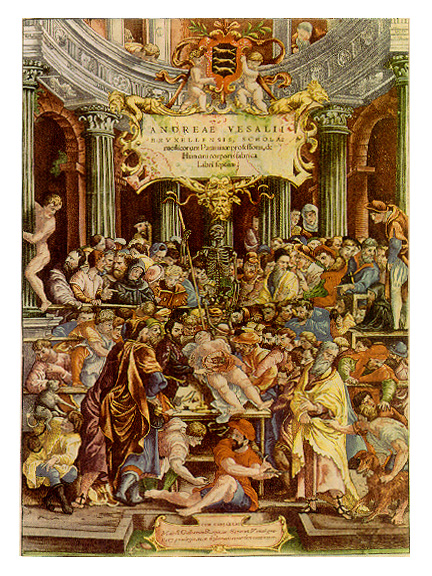Frontispiece of Vesalius' De Fabrica

Frontispiece of Vesalius' "De Humani Corporis Fabrica", 1543
This tinted version of the frontispiece appears in a copy of "De Fabrica" previously owned by Haskell F. Norman, reproduced in the New York Times of March 10, 1998 on page F4, from which this scan was made. It is believed that the tinted version was in a copy given by Vesalius to the Emperor Charles V, to whom the book was dedicated.
Note the following additional elements that are noticeable in the drawing:
- Above the cadaver is a plaque identifying Vesalius as "Andreae Vesali" of Brussells, along with information on the book. Above the plaque are two cherubins hanging on to either side of a coat of arms consisting of three weasels, the coat of arms of Vesalius' family.
- At both sides of the frontispiece are two figures -- one nude, one clothed -- standing on ledges overlooking the dissection scene, each being observed by one of the spectators. The nude figure presumably represents the artistic study of the nude which the anatomist needs for his understanding of the surface anatomy of the human body; the clothed figure is there perhaps for balance; in any case, both observe the dissection below.
- A monkey can be seen at the bottom left of the image, and a dog at the right, attracting the attention of some spectators. These may indicate the importance of animal studies for anatomy.
- The barber-surgeons or demonstrators who previously did dissections are relegated to the space below the table, playing a game to amuse themselves or perhaps arguing. They have been replaced by the professor-dissector above them and to the left of the table.
- The ampitheater in which the dissection is taking place is decorated with Greek columns and ornate adornments, once again illustrating Vesalius' artistic treatment of scientific scenes.

